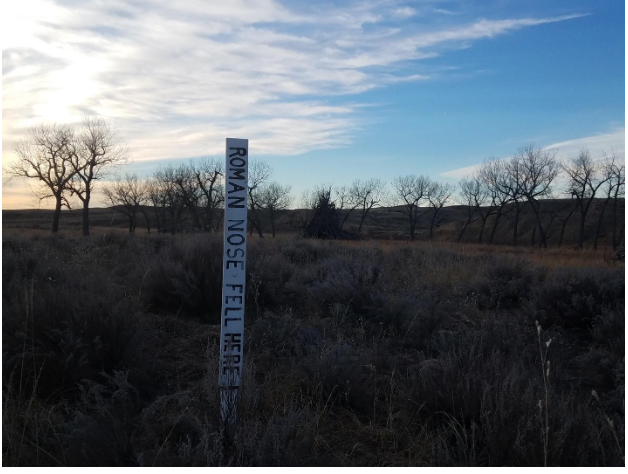Beecher Island just off the Arikaree River // Emily Lovell
By: Emily Lovell, Associate Editor
Less than twenty miles south of Wray, CO lies the Beecher Island battleground. On September 17, 1868, 50 citizen scouts under the command of Colonel George A. Forsyth fought against roughly 600 Cheyenne, Sioux, and Arapaho warriors. Though the island where the battle took place has since been washed away by flooding, the location’s history lives on.
A week previously, on September 10, word had reached Fort Wallace of a Native American raid on a freight train wagon only 13 miles away from the fort. Forsyth and his scouts were dispatched to track the fleeing warriors. Five days later, they uncovered tracks made by entire Native American villages along the Republican River. Even though the scouts’ food supplies were dwindling, they were unable to hunt game with such a large Indian force nearby and they continued their pursuit.
September 16 saw Colonel Forsyth’s men making camp in a valley on the Arikaree River, one of the Republican River’s tributaries, which was only a small stream since it was the dry season. They prepared to attack the Native Americans the next morning. Little did they know that the Native Americans were aware of their presence.
While the bulk of their forces gathered on surrounding hilltops, a small band of warriors led by Starving Elk and Little Hawk searched for the scouts throughout the night. They planned to stampede the scouts’ horses. However, they didn’t spot the scouts’ campfires until dawn on the 17. A small battle ensued and Starving Elk got away with only seven horses as the all the horses and mules had been well secured with picket-pins. The Native Americans had lost the element of surprise, but as hundreds of warriors on the hilltops prepared to attack, the scouts found themselves drastically outnumbered.
Luckily, a low sandbar on the Arikaree provided the natural fortification that the scouts needed. Only 200 feet long and 40 feet wide, the sandy island rose about a foot above the water and split the river into two streams 15 feet wide and five inches deep creating a natural moat. A lone cottonwood tree grew on the sandbar as well as a small thicket of willows and alders. The scouts rushed for the island “like a flock of scared quail” as Scout John Hurst would later recall. When the scouts reached the island, they began digging pits with the butts of their rifles, tin plates, knives, or their bare hands.
Lieutenant Fredrick H. Beecher, a veteran of the Battle of Gettysburg and Colonel Forsyth’s executive officer, and two other scouts provided covering fire while the others made for the island. Beecher died during the battle and the island was named after him.
Roman Nose, a Cheyenne Dog Soldier, famous for his courage and luck in battle, led a charge on horseback down into the valley. Legend has it that Roman Nose had a premonition of death before the battle. He had eaten a meal with a metal fork, an act which was believed to attract metal bullets during battle. He did not have time to undergo the purification ritual necessary to restore the magical powers of his protective talisman, and the Battle of Beecher Island would prove to be his last.
The scouts were armed with Spencer rifles. These firearms used copper cartridges stored in a seven-round tube containing a spring that enabled the rounds to be fired one after another without the need to stop and reload. Although the Native Americans made several more mounted charges, the scouts were able to fend them off with their innovative weapons. Six of the scouts were killed in the fighting, including the medical officer Dr. John H. Mooers, and sixteen were wounded. Colonel Forsyth himself had been shot in the leg and he ended up having to remove the bullet himself. It is unknown how many Native Americans were killed. Gradually, the Indians turned their assault into a siege and killed all of the scouts’ horses to prevent an escape.
Aware of the Native Americans’ new plan, the scouts realized they needed to send for reinforcements. At midnight, once the fighting had abated, scouts Simpson “Jack” Stillwell and Pierre Trudeau stealthily crept off the island. They went barefoot while carrying their boots and walking backwards so their footprints would look like those left by Native Americans.
Meanwhile, Colonel Forsyth and his men found themselves facing starvation. They searched their saddlebags for the last of their provisions and then resorted to cutting strips of meat off the dead horses and mules. Some of the meat was hung on branches in the hope that it would dry out and last longer. In order to cover the putrid smell and taste of the decaying horse meat, some of the men sprinkled gun powder on it.
According to legend, Stillwell and Trudeau hid in a buffalo carcass to evade capture while they made the 110 mile trek to Fort Wallace in Kansas. When they finally arrived, three separate parties disembarked on a rescue mission, although they were uncertain where exactly the island was located. The 10th Cavalry Buffalo Soldiers under Captain Louis Henry Carpenter encountered John Donovan, another scout sent to find aide, on September 25. They were the first to arrive on scene and found that the Native Americans had already gone. The dead scouts were buried on the island.

